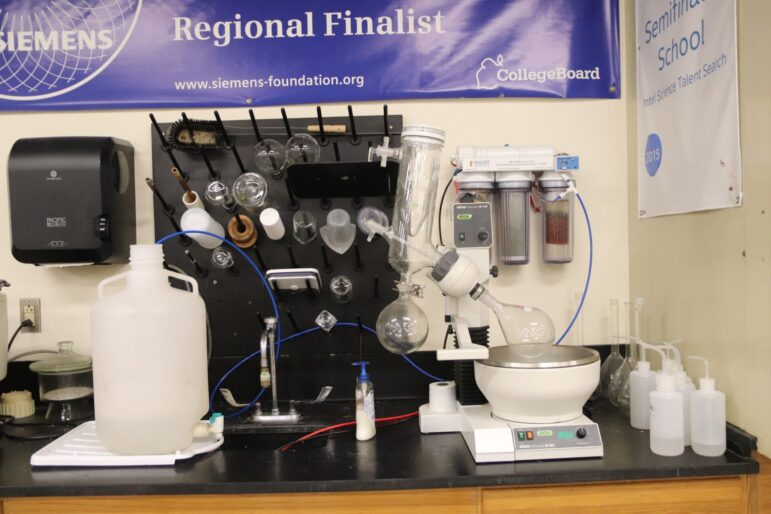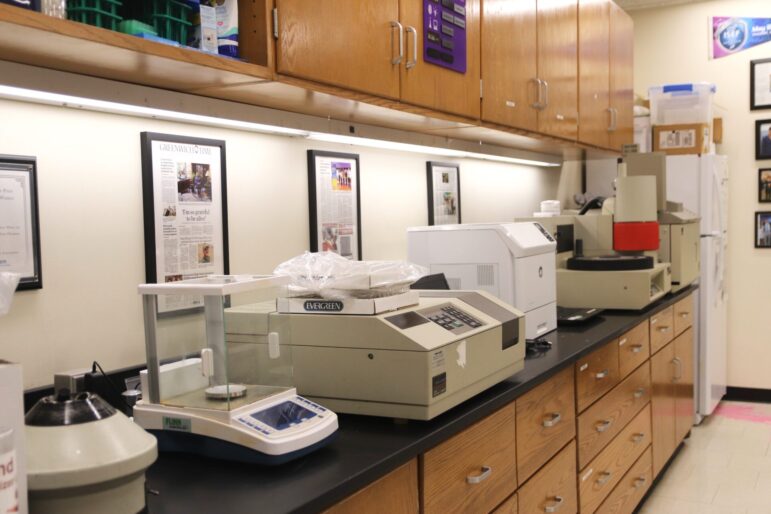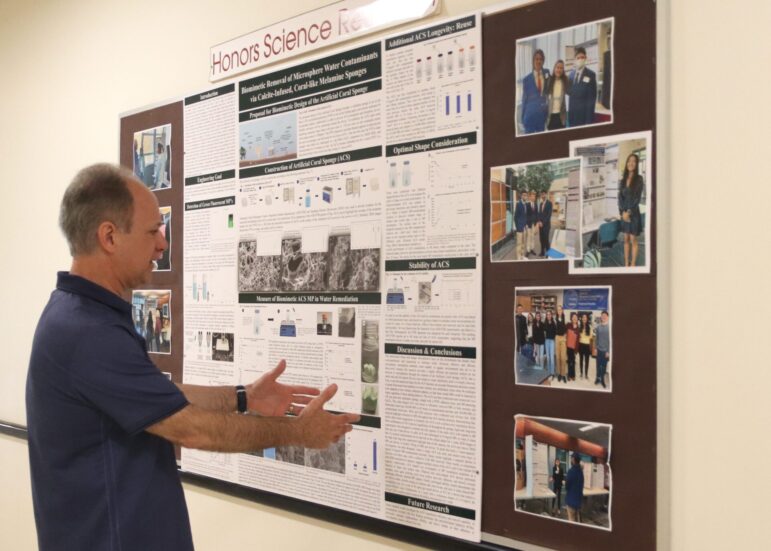At Greenwich High School, the Independent Science Research Program led by Andy Bramante has been a great source of pride for Greenwich Public Schools, with a stream of student awards, accolades, and eye-popping moments during BOE student recognition ceremonies where descriptions of student projects leave the audience speechless.
Last week, Bramante was visited by Susie Baker, a former GHS science teacher who taught Marine Biology and Honors Oceanography and retired in 2004 after 25 years.

Bramante’s students consistently win some of the highest state, national and international prizes for science related research, including the Google Science Fair and Regeneron/Intel Science Talent Search.
The student projects, many with life-changing implications, have earned a host of praise, including scholarships and even an appearance on The Late Show with Stephen Colbert.
Under Bramante, self-deprecating and modest by nature, the program has flourished. He even inspired journalist Heather Won Tesoriero to write her book, The Class, that The Wall Street Journal described as, “A complex portrait of the ups and downs of teaching in a culture that undervalues what teaching delivers.”
“Disney bough the rights,” Bramante said, with a touch of a smile.
In fact the district piloted an expansion of Bramante’s science research program to all three of Greenwich’s middle schools. The program, Junior Innovators, enrolled about 45 students, who applied for the program in 7th grade and visited the school one morning a week this year for a taste of the opportunity that awaits them at GHS.
Bramante credited Greenwich Schools superintendent Dr. Toni Jones for championing the expansion to 8th graders.
“They come once a week, get introduced to the equipment and learn to use it,” he said.
It would be difficult to replicate the science research program in another school district for a variety of reasons.
For starters Mr. Bramante, who left a successful career as a corporate scientist to be a public school teacher, has been able to leverage his work connections to secure used but sophisticated science equipment. His ties to the corporate world extend to the ability to keep the equipment in good repair despite a shoestring budget.
Bramante, in typical fashion, doesn’t take credit for his students’ successes on the competitive science fair circuit. In fact, he is reluctant to create the expectation that every student will be a winner.
He said there are times when a student will tell him science research isn’t their thing after all. In those cases, Bramante tells them that it’s all right and certainly not a failure, but rather what life is about: exploring different activities and learning about yourself.

And while Bramante is content to bask in the achievements of his students, recently he was elected to the Connecticut Academy of Science and Engineering, in recognition of his commitment to the education of students in the Independent Science Research Program since 2006. The Academy recognized him last month at their annual meeting in Branford.
“There’s no place like this anywhere,” Baker said of the program. “The breath of Andy’s background is incredible. He’s a scientist with a broad background. He sees how to solve problems because of his work experience, and he knows all the equipment.”
“I was a tech applications specialist and field product specialist for all the most advanced technology,” Bramante explained, adding that he worked at both Hitachi and PerkinElmer for many years.
“Really all the equipment are donations, not by the company but by the individuals I met along the way and trained,” Bramante explained, adding that the equipment is usable but can’t be resold.
This is where Bramante works his magic, because his school budget is fixed.
“What’s nice about it is everything in here I can repair,” he said. ” That’s what makes it come together – I can call my friends who donated these things and ask for a part. A typical service engineer saves parts.”
Bramante used to take students to New York City to use the electron microscope at Mt. Sinai, but he said it was frustrating to leave other students behind.
“I connected with a Hitachi friend – when we were in our early 20s we were magnetic resonance specialists. We started chatting and I said I could use an electron microscope. He got me in touch with a manager I knew, who he said there was one in a warehouse in Maryland. That’s something even a university would struggle to have.”


As for FTIR spectrometers which cost in the tens of thousands of dollars, Bramante said that at a wedding in California he mentioned his students need for a spectrometer to a buddy he had trained years earlier as a service engineer.
“The service engineers know I service it myself,” Bramante said, adding that spectrometers are taken in on trade and can’t be resold. “He said,’ You ship it and it’s yours.'”
The back story of another piece of equipment – a gas chromatograph – was already at GHS. Bramante explained that Clairol had closed down and the machine was broken.
“First order of business was to get it fixed,” he recalled. “I contacted a buddy. I got him a pizza.”
“And the equipment that allows students to do their research in the building rather than travel to a university,” he explained. “But also, the GHS students own their own research as opposed to plugging into someone else’s project during the summer and being part of someone else’s team. “
“That’s a great opportunity to see a university style lab, but here they originate design and execute the entire thing.”
Baker agreed. “When you go to one of these fairs, the winners all say, for example, their work was done at Yale over the summer or Mt. Sinai, or in the labs as Sloane Kettering. They use the word we a lot.”
“I tell them there is no we. It’s you. You own it, and I make an effort to have them articulate that,” Bramante said.
Ms Baker interrupted to say the program’s success reflected much more than the equipment.
“Every competitive high school has tried to hire him away,” she said. “Andy is the one who makes this work.”
Bramante smiled. “It really boils down to the caliber of students. There is not another school out there anywhere with the pool of candidates that GHS has.”
But also, other schools that offer science research typically organize their programs as clubs or after school enrichment activities. Bramante said as soon as the effort lacks the structure of a class during the school day, the students have other demands on their time.
“There is intense competition for the kids’ time, they have all these other things they do music, dance, sports,” he said. “The idea they can do it here (in the classroom) is a big help.”

Bramante said it’s rewarding to see a student put in the effort because they have chosen something that excites them.
He said, for example, Raina Jain, who graduated three years earlier, studied bee colony collapse (Colony Collapse Disorder) and realized the bees had pesticides all over their feet.
“Raina developed an entrance way that would have a gel that would irritate the mites so they dislodge and die. The way she went about solving the many problems – these kids don’t have the biases we do; they see things the way they are.”
Baker said some student research is in the medical field, some is in the natural world.
On that note, Mr. Bramante mentoned the research of GHS junior Naomi Park who won the Environmental Protection Agency’s 2023 Regeneron International Science and Engineering Fair (ISEF) award. Her idea started by reimagining and repurposing a styrofoam floatation device for a swimming pool.
Her project, “Concurrent Removal of Rising, Soluble Ocean Carbon Dioxide and Oil-in-Water Contaminants via Multi-Functional Remediation Framework,” tackles three environmental issues: styrofoam waste, water quality, and soluble oil remediation.
Mr. Bramante said the enrollment in his class used to be more evenly split between boys and girls. Today it’s shifted to more girls than boys.
Students apply for the program in the spring of the preceding school year. They have about a month to write an original research proposal.
“That’s difficult,” Bramante said. “That separates out the kids who are truly interested. What I’m looking for is originality of thought.”
Still, he said while it is competitive to get into the class, the class itself is not about science competition.
“It’s about learning how to talk, articulate and imagine,” he said. “It’s what happens when they push forward and are innovative and want to share. That’s the evolution of the process! I tell them, define success, did you learn something?”
“My motto is I’m teaching colleagues, not teaching kids. If you treat everybody like adults they rise to the occasion – usually,” Bramante said.
Baker added an observation. “Andy works seven days a week and has no school vacations off.”
“Every day is different! You get to know the kids in a more intimate way, you’re their mentor,” he said. “The big push these days is student centered learning: This is it.”